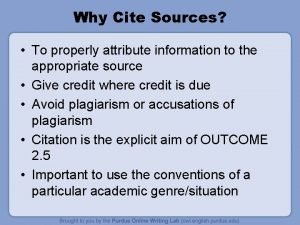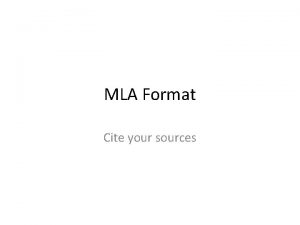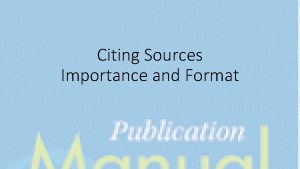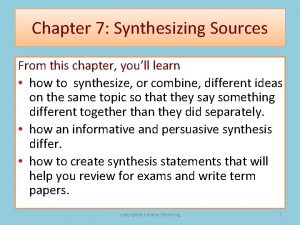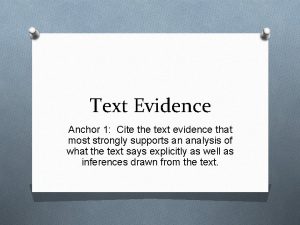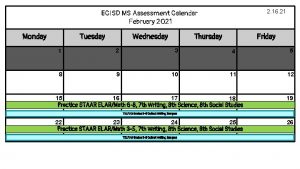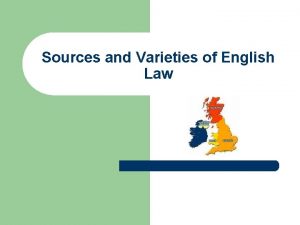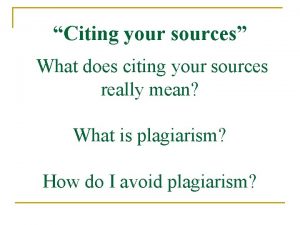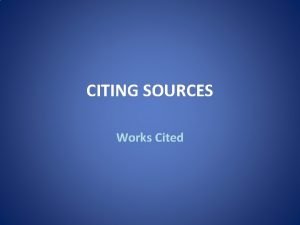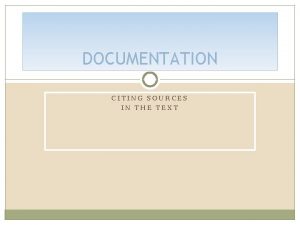Citing Sources English 104 42 Spring 2011 Citing










- Slides: 10

Citing Sources English 104 – 42 Spring 2011

Citing Sources using MLA 3 components go into citing a source: • MLA discourse styles (Quotations, Paraphrases, Summaries) • In-Text Citations, after the Q, P, or S. • Attributive Tags, prior to Q, P, or S.

Discourse Styles: What is… Summary? Paraphrase? Quotation? • Brief Restatement of Direct description of exact ideas and representation of main idea information in the words w/ new words. quotation marks • Much shorter than original About the same Exact words even text length as the w/spelling or original, or grammatical errors • Your own longer, than words & Same length as original text. writing style original unless you In your own use an ellipses (…) words and or brackets [ ] writing style.

In-Text Citations • Parenthetical notes, imbedded in a paper, that tell readers that particular information in the paper was borrowed from a specific source. • Used after any quotation (Q), paraphrase (P), or summary (S) from another source • Usually includes, in parentheses, the last name of the author and page number, with exceptions • Refers readers to the Works Cited

Example

In-Text Citations: General Rules • Usually, provide only last name of author(s) and page number(s) on which the information was found. E. g. (Miller-Cochran and Rodridgo 255). • In-text citations should come after quotation marks and before end punctuation of sentences. • All Q, P, or S used in a paper (in fact, all information borrowed from another source) must include an in-text citation at the end. • For more information, see The Ball Point Chapter 5, sections 2 -3; or the Purdue Online Writing Lab (“MLA In -Text Citations: The Basics” link); or Wadsworth 252254.

Attributive Tags Brief statements prior to a Q, P, or S that identifies the source of that information Makes clear where secondary source information begins (The in-text citation shows where it ends) E. G. “According to researchers…”, “Smith writes that…”, “CNN reports that…”

Citation & Quotation For a Quotation… Thus, in his typical blunt eloquence, Peter Ramus responds to Quintilian by writing, “I assert indeed that such a definition of an orator seems to me to be useless and stupid” (683).

Citation & Paraphrase For a Paraphrase… One book, called Teaching to Transgress, describes the boundlessness of language—how we can’t fully control what we communicate and how we inevitably reveal things about ourselves we never intended (hooks 222).

Citation & Summary For a Summary… Our communication takes three general shapes, called, “modes of communication”: written, spoken, or visual. Each mode calls on different human senses, involve our audiences in different ways, and are good for different kinds of purposes and sending different kinds of information (Wysocki and Lynch 178 -79).
 How to cite multiple authors
How to cite multiple authors What is mla format for citing sources
What is mla format for citing sources Importance of citing evidence
Importance of citing evidence Synthesizing sources examples
Synthesizing sources examples Sentence starters for citing evidence
Sentence starters for citing evidence Ecisd spring break 2011
Ecisd spring break 2011 Print sources and web sources
Print sources and web sources Important of water management
Important of water management Spring summer fall winter and spring cast
Spring summer fall winter and spring cast February is winter or spring
February is winter or spring The sources of english law
The sources of english law
